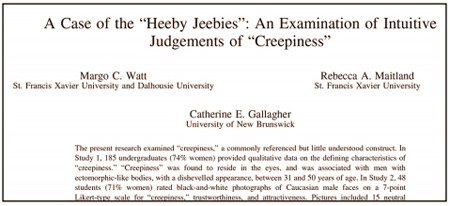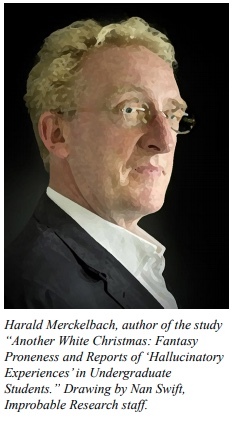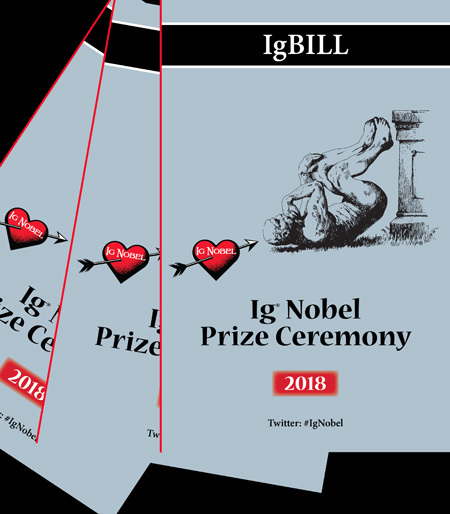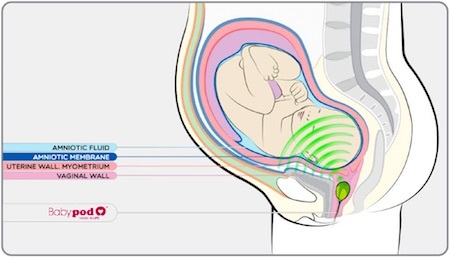Marc Abrahams's Blog, page 173
September 3, 2018
IgBill, the program guide to the Ig Nobel Prize Ceremony
IgBill, the printed program handed to every ticketholder at the Ig Nobel Prize ceremony, is now also online as a downloadable PDF. Download it, if you like!
It’s got info about what, more or less, will happen at the ceremony. IgBill even includes the complete libretto to “The Broken Heart Opera“—the new mini-opera that will be part of the ceremony.
We hope you will join us at the 28th First Annual Ig Nobel Prize ceremony, on Thursday evening, September 13, 2018, in Sanders Theatre at Harvard University. A few TICKETS are still available. And if you can’t be there in person, gather some friends, wherever you are, and watch the live webcast.

The semiotics of lamppost stickers in Birmingham (new study)
“This article set out to examine the role of stickers in urban semiotic landscapes by focusing on their spatial distribution, agency, and linguistic practices involved in their design and production, function and discursive distribution. The analysis of 1191 signs recorded on Digbeth, a street in central Birmingham, UK, has revealed that stickers form the predominant genre in this corpus (60%).”
The study revealed that the majority of stickers (329) were located on lampposts. [see below]
And also showed (for example) that 22.5% were commercial, and 18.5% were artistic in nature. [see below]
 See: ‘Lamppost networks* : stickers as a genre in urban semiotic landscape’ authored by Professor Gertrud K. Reershemius of the School of Languages and Social Sciences, Aston University, Birmingham, UK. It’s scheduled for publication in the journal Social Semiotics
See: ‘Lamppost networks* : stickers as a genre in urban semiotic landscape’ authored by Professor Gertrud K. Reershemius of the School of Languages and Social Sciences, Aston University, Birmingham, UK. It’s scheduled for publication in the journal Social Semiotics
*This term was coined by Leonie Gaiser and Yaron Matras as part of their presentation for the conference “Multilingual Landscapes: Planning, Policy, and Contact Linguistic Perspectives”. 21–22 May 2018, University of Manchester. ‘Toward an integrated approach to urban linguistic landscapes’
[ Research research by Martin Gardiner ]

August 30, 2018
Dr Farahbakhsh’s infant washer-dryer invention (new patent)
Many are already accustomed to leaving the task of cleaning and drying the dirty dishes to a dishwasher – what if it were possible to do something similar with an infant in need of a diaper* change? A newly issued US patent granted to inventor Iman Farahbakhsh, of Quchan, Iran, explains the concept :
“Changing diapers is an art that many parents or caregivers may find difficult to acquire or perform conveniently.
[…] a need exists for an infant washer and diaper changing apparatus that can reduce or eliminate the inconvenience associated with changing diapers of the infants as well as reducing the water consumed during changing diapers of the infant.
In one implementation, the infant changing and washing apparatus may automatically change the diaper of an infant and wash and dry the infant. The infant changing and washing apparatus may be a light, compact, and easily portable and may be comparable to the commercial washing machines in size and shape. The apparatus may include an outlet bin for the used diaper, or may conveniently be used in connection with a washing apparatus to subsequently wash the diaper. The apparatus further may wash and dry the infant.
The apparatus may be said to be automatic in some implementations, in that once the infant is placed inside the apparatus, various steps may in some cases by carried out automatically without needing the operator to touch the infant or interact manually with the diaper or infant during the changing process, which may create a more sanitary environment for the ambient area and the operator’s hands.”
See United States Patent 10,034,582, July 31, 2018, ‘Infant washer and diaper-changer apparatus and method’
* That’s ‘nappy’ for our UK readers

August 29, 2018
On Creepiness [research study]
“A Case of The ‘Heeby Jeebies’: An Examination of Intuitive Judgements of ‘Creepiness’ ”, Margo C. Watt, Rebecca A. Maitland, and Catherine E. Gallagher, Canadian Journal of Behavioural Science / Revue Canadienne des Sciences du Comportement, vol. 49, no. 1, January 2017, pp. 58-69. The authors, at St. Francis Xavier University, Dalhousie University, and the University of New Brunswick, Canada, explain:

“The present research examined ‘creepiness,’ a commonly referenced but little understood construct. In Study 1, 185 undergraduates (74% women) provided qualitative data on the defining characteristics of ‘creepiness.’ ‘Creepiness’ was found to reside in the eyes, and was associated with men with ectomorphic-like bodies, with a dishevelled appearance, between 31 and 50 years of age. In Study 2, 48 students (71% women) rated black-and-white photographs of Caucasian male faces on a 7-point Likert-type scale for ‘creepiness,’ trustworthiness, and attractiveness.”
 Read that and more, in the column “Soft Is Hard—Further evidence why the “soft” sciences are the hardest to do well” [free, downloadable PDF], in the special NOISE issue of the Annals of Improbable Research.
Read that and more, in the column “Soft Is Hard—Further evidence why the “soft” sciences are the hardest to do well” [free, downloadable PDF], in the special NOISE issue of the Annals of Improbable Research.
For heaps of improbable research, subscribe to the magazine (or if you like, buy single issues). The magazine has six new issues a year, all in PDF form.

August 28, 2018
Hearing “White Christmas” in white noise [research study]
 “Another White Christmas: Fantasy Proneness and Reports of ‘Hallucinatory Experiences’ in Undergraduate Students,” Harald Merckelbach and Vincent van de Ven, Journal of Behavior Therapy and Experimental Psychiatry, vol. 32, no. 3, September 2001, pp. 137-144. (Thanks to Kristine Danowski for bringing this to our attention.) The authors, at Maastricht University, The Netherlands, report:
“Another White Christmas: Fantasy Proneness and Reports of ‘Hallucinatory Experiences’ in Undergraduate Students,” Harald Merckelbach and Vincent van de Ven, Journal of Behavior Therapy and Experimental Psychiatry, vol. 32, no. 3, September 2001, pp. 137-144. (Thanks to Kristine Danowski for bringing this to our attention.) The authors, at Maastricht University, The Netherlands, report:
“44 undergraduate students were asked to listen to white noise and instructed to press a button when they believed hearing a recording of Bing Crosby’s White Christmas without this record actually being presented. Fourteen participants (32%) pressed the button at least once…. hallucinatory reports obtained during the White Christmas test [might] reflect a non-specific preference for odd items rather than schizophrenia-like, internal experiences.”
 Read that and more, in the column “Music and Noise Research—Explorations of artistic and other vibrations” [free, downloadable PDF], in the special NOISE issue of the Annals of Improbable Research.
Read that and more, in the column “Music and Noise Research—Explorations of artistic and other vibrations” [free, downloadable PDF], in the special NOISE issue of the Annals of Improbable Research.
For heaps of improbable research, subscribe to the magazine (or if you like, buy single issues). The magazine has six new issues a year, all in PDF form.

August 27, 2018
Evaluating an app which nags users to apologize to their phones
Building (in part) on previous research into the potential benefits of superfluous apologies, researchers Alice Lam, Randy Hsu and Ivan Lobachev of the Department of Electrical and Computer Engineering, University of British Columbia, Canada, decided to investigate whether it might be possible to increase phone users’ “emotional connection” with their phone, by nudging them to frequently apologize to it.
Their experiments were designed around an app (called Pet Phone) which nagged users to apologize when the phone experienced a negative event of some kind – e.g. if the user allowed its battery to discharge too far, or if the phone was dropped.
“We extend this concept to encourage a smartphone user to adopt a more caretaking role toward their phone. By prompting the user to apologize for perceived transgressions, we can create the self-perception that ‘I am someone who is concerned for my phone’s wellbeing’, thus forming an emotional connection between user and phone. It is worth noting that the apology may not need to be entirely heartfelt and sincere, as superfluous apologies still demonstrate empathetic concern.”
The experiments showed, however, that there could be room for improvements with regard to the app’s emotional-bond-enhancement potential :
“Due to time constraints, we designed the application to output a high number of apology prompts, with the intention of encouraging users to apologize frequently to their phones in a short period of time. Instead, it appears that users simply learned to ignore the high volume of apology prompts.”
Put another way :
“The fact that there was a decrease in apologies without a corresponding decrease in apology-causing events suggests that users learned to ignore the notifications generated by the app, instead of responding by apologizing.” [see graph]
 For full details see: Pet Phone: Using Apologies to Enhance User-Smartphone Attachment
For full details see: Pet Phone: Using Apologies to Enhance User-Smartphone Attachment
BONUS (apologetically related)

August 26, 2018
(Belated) Wedding congratulations to a Spam-Managerial Ig Nobel Prize winner
We have only just now seen news of the 2017 wedding of the manager of the Spam Museum. We offer our heartiest, most tasteful congratulations.
Why this matters to us: The 1992 Ig Nobel Prize for nutrition was awarded to the utilizers of Spam, courageous consumers of canned comestibles, for 54 years of undiscriminating digestion.
 The wedding announcement, in the Palm Beach Daily News‘s Shiny Section section, says, in part:
The wedding announcement, in the Palm Beach Daily News‘s Shiny Section section, says, in part:
Palm Beach Wedding: Mr. and Mrs. Kenneth Johnson
The marriage of Savile Collins de Montenay FitzAlan de Dinan Lord to Kenneth Lowell Harvey Oscar Johnson took place Saturday, Jan. 14, 2017, in Palm Beach….
The marriage of Savile Collins de Montenay FitzAlan de Dinan Lord to Kenneth Lowell Harvey Oscar Johnson took place Saturday, Jan. 14, 2017, in Palm Beach.
The Rev. James R. Harlan, rector, was celebrant for the double-ring ceremony, which took place at The Episcopal Church of Bethesda-by-the-Sea.
Harold Pysher was the organist.
The bride is the daughter of Eleanor Louise De Peverel Collins Lord of Palm Beach and Dr. Jerome Edmund Lord of Boynton Beach and Washington, D.C.
The bridegroom is the son of Mr. and Mrs. Kenneth Lowell Johnson of Barnesville, Minn.
The bride wore an off-the-shoulder vintage satin and beaded gown with a 10-foot train and an organza veil. She was attended by sister Wallis Jennings dePantulf Lord-Hart of Milton Keynes, England, and sister-in-law Maria Yip Lord of New York as matrons of honor; and her sisters, Stavely Hampston deHodnet Lord of Washington, D.C., and Dorian Warfield d’Amours Lord of Minneapolis as maids of honor.
Ella Louise FitzWarin Lord-Hart, niece of the bride, was the flower girl.
The bridegroom was attended by the bride’s brother, Hayes Alexander FitzWarin Lord of New York, and the bride’s brother-in-law, Andrew Richard Hart of Milton Keynes, England, as best men.
Ushers were John Buxton of West Palm Beach, Shawn Steven Osgood of Palm Springs and Hayes Li Collins Lord of New York.
The bride, who will be known professionally by her maiden name, is a graduate of The Fay School and Miss Porter’s School. She attended Mount Holyoke College and graduated from Georgetown University with a bachelor’s degree in American government.
[The bride] was presented to society at the Infirmary Ball in New York, the Batchelor’s Cotillon in Baltimore, Queen Charlotte’s Ball in London, and the Opera Ball in Vienna, Austria.
She is descended from the English baron Foulques FitzWarin, who was at the Magna Carta and is the subject of the famous 13th-century manuscript The Romance of Fulques Fitzwarenne; and of his father, Guarin de Metz, the Lorraine noble who won the famous tournament at Whittington Castle in Shropshire, England.
She is a member of the DAR, the Daughters of the Colonial Wars, the Society of the Friends of St. George’s and the Descendants of the Knights of the Garter, and of the Metropolitan Club in Washington, D.C….
The bride is manager of the SPAM® Museum in Austin, Minn., and community relations at Hormel Foods.
The bridegroom, a second lieutenant in the Civil Air patrol and a member of Mensa International, is director of Customized Training, Business Solutions and Entrepreneurship at Riverland Community College in Minnesota.
BONUS INFO: This was the first Spam-or-spam-related Ig Nobel Prize. The next came five years later. The 1997 Ig Nobel Prize for communications was awarded to Sanford [“Spamford”] Wallace, president of Cyber Promotions of Philadelphia—neither rain nor sleet nor dark of night have stayed this self-appointed courier from delivering electronic junk mail to all the world. The next came in 2005, when the Ig Nobel Literature Prize was awarded to The Internet entrepreneurs of Nigeria, for creating and then using e-mail to distribute a bold series of short stories, thus introducing millions of readers to a cast of rich characters—General Sani Abacha, Mrs. Mariam Sanni Abacha, Barrister Jon A Mbeki Esq., and others—each of whom requires just a small amount of expense money so as to obtain access to the great wealth to which they are entitled and which they would like to share with the kind person who assists them.
BONUS: Video of Monty Python’s tribute to Spam:

August 25, 2018
The Barcelona concert for embryos: Sharon Corr & Álex Ubago
“Sharon Corr and Álex Ubago celebrated Institut Marquès’ Ig Nobel Prize by singing to the embryos.” That’s the headline on a report by Top40-Charts. The report explains how Sharon Corr (of The Corrs) and Álex Ubago came to be involved in this historic concert:
Institut Marquès, the worldwide leading fertility centre, has hosted a new live concert for embryos at its laboratory in Barcelona. and Álex Ubago performed for hundreds of embryos growing in the incubators at Barcelona, Rome and Clane (Ireland)….
Sharon Corr, singer-songwriter member of the famous Irish band The Corrs, and Álex Ubago featured several songs, i.e. “Amarrado a ti” (“Tied to you”) and “Buenos Aires”. “It was a very emotional experience. It is great to think that possibly we can be part of their future. I am not surprised that music really helps the embryos to form; music is the greatest therapy in the world so I feel very honoured to be asked to do this,” stated Sharon Corr. This performance follows the lead of other artists such as the famous Spanish singer-songwriter Antonio Orozco. Institut Marquès plans to offer further live concerts at their laboratories in the coming future….
These events fall within the works undertaken by Institut Marquès on how music benefits the embryonic and fetal development. Those studies were awarded last September by Harvard University with the Ig Nobel Medicine Prize. The goal of this award is to promote that scientists from all over the world can present their studies to the audience in a pleasant and enjoyable way. The Ig Nobel organisation chose Institut Marquès researchers to present their work on a tour around the most important Universities in Europe in the past month of April . Doctor López-Teijón, Institut Marquès’ Director, alongside Doctor Álex Garcia-Faura, Scientific Director of the centre, presented their studies on fotal hearing the positive effects of music at the beginning of life at the Karolinska Institute and at the Aarhus University.
Here’s video of Doctor López-Teijón, Institut Marquès’ Director, who, together with colleagues Álex García-Faura, Alberto Prats-Galino, and Luis Pallarés Aniorte, was awarded that Ig Nobel Prize for showing that a developing human fetus responds more strongly to music that is played electromechanically inside the mother’s vagina than to music that is played electromechanically on the mother’s belly. The video gives a quick tour of the facilities in Barcelona:
REMINDER: The clinic’s Ig Nobel Prize-winning work included the development of Babypod, the device for playing vagina music properly.

August 24, 2018
Savoring some salacious scientific discoveries: Ducks
True Facts produced this short video called “True Facts About The Duck.”

Some of those facts were discovered by Patricia Brennan and Kees Moeliker, both of whom contributed to production of this video.
Some years ago Patricia Brennan summarized her discoveries in a 24/7 Lecture at the Ig Nobel Prize ceremony.
Some years before that Kees Moeliker was awarded an Ig Nobel Prize for biology, for his study “The First Case of Homosexual Necrophilia in the Mallard Anas platyrhynchos (Aves: Anatidae).”
(Thank you to Daniel Rosenberg for bringing this to our attention.)

August 23, 2018
Superfluous apologies – an easy-to-use tool for social influencers?
Superfluous Apologies have been defined as :
“Expressions of regret for an undesirable circumstance that is clearly outside of one’s control.”
That’s according to the Decision Processes Lab at the Operations, Information and Decisions Department, The Wharton School, The University of Pennsylvania, US, which has recently found, by experiment, that :
“Superfluous apologies represent a powerful and easy-to-use tool for social influence. Even in the absence of culpability, individuals can increase trust and liking by saying ‘I’m sorry’ – even if they are merely ‘sorry’ about the rain.”
With the proviso, though, that :
“Some scholars have suggested that there may be drawbacks to issuing an apology. We did not identify any drawbacks in our investigation. Still, it is quite possible that the repeated use of superfluous apologies or the delivery of a superfluous apology that appears insincere may yield different results.“
See:’ I’m Sorry About the Rain! Superfluous Apologies Demonstrate Empathic Concern and Increase Trust ‘ Social Psychological and Personality Science, Volume: 5 issue: 4, page(s): 467-474. A full copy of which may be found here.
Note: The experimenters also found that ;
“ […] individuals were more likely to hand over their cell phone to a stranger in a train station (our measure of trust) when they received a superfluous apology than when they did not.” [see photo below]
Coming Soon : Getting smartphone users to apologize to their phones
BONUS (apologetically related) :

Marc Abrahams's Blog
- Marc Abrahams's profile
- 14 followers









